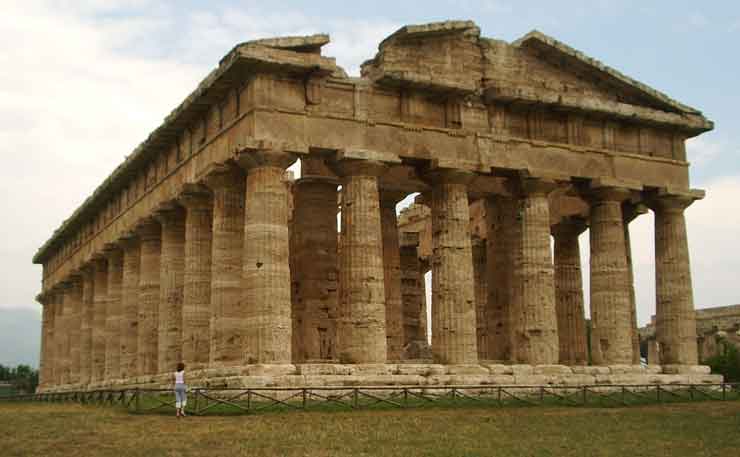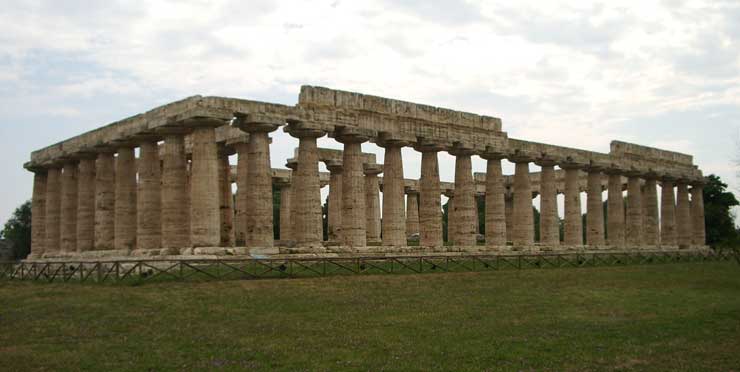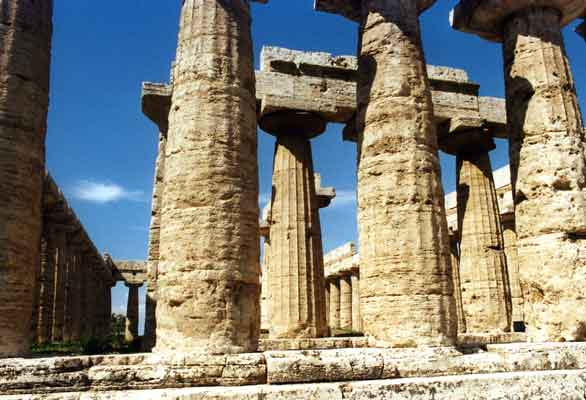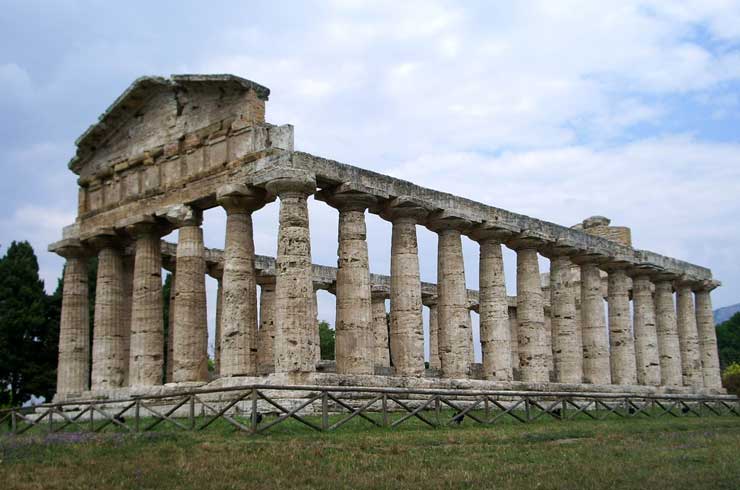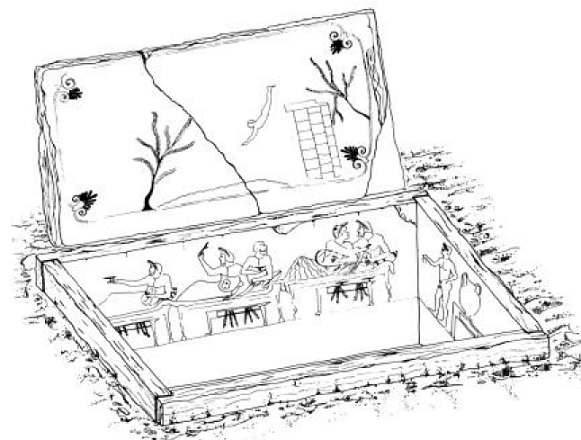.
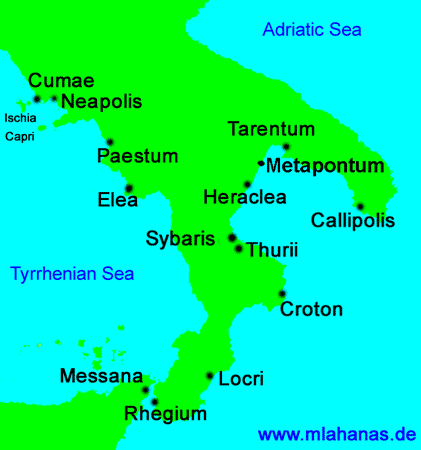
Paestum is the classical Roman name of a major Graeco-Roman city in the Campania region of Italy. It is located near the coast about 85 km SE of Naples in the province of Salerno and belongs to the comune of Capaccio.
History
Founded around the end of the 7th century BC[1] by colonists from the Greek city of Sybaris, and originally known as Poseidonia. Outside of archaeological evidence very little is known about Paestum during its its first centuries. Archaeological evidence indicates that the city was expanding with the building of roads, temples and other features of a growing city. Coinage, architecture and molded votive figurines all attest to close relations maintained with Metaponto in the sixth and fifth centuries. It is not until the end of the fifth century BCE that the city is mentioned, when according to Strabo the city was conquered by the Lucani. From the archaeological evidence it appears that the two cultures, Greek and Oscan, were able to get together and thrive. What is known is it later became the Roman city of Paestum in 273 BCE after the Graeco-Italian Poseidonians sided with the loser, Pyrrhus, in war against Rome during the first quarter of the third century BCE.
During the invasion of Italy by Hannibal the city remained faithful to Rome and afterwards was granted special favours such as the minting of its coinage. The city continued to prosper during the Roman imperial period, but started to go into decline between the 4th and 7th centuries. It was abandoned during the Middle Ages and its ruins only came to notice again in the 18th century, following the rediscovery of the Roman cities of Pompeii and Herculaneum. The decline and desertion were probably due to changes in local land drainage patterns, leading to swampy malarial conditions (this is difficult to picture, with the present aridity; the site is now left to lizards and a few tourists).
Overview
The main features of the site today are the standing remains of three major temples in Doric style, dating from the first half of the 6th century BC. These were dedicated to Hera, Apollo and Athena, although they have traditionally been identified as a basilica and temples of Neptune and Ceres, owing to 18th-century misattribution.
The city of Paestum covers an area of approximately 120 hectares. Its only the 25 hectares that contain the three main temples that have excavated. The other 95 hectares remain on private land and have not been excavated. The city is surrounded by defensive walls that still stand. The walls are approximately 4750 m long, 5 - 7 m thick and 15 m high. Positioned along the wall are 24 square and round towers. There may have been up to 28 but some of them were destroyed during the construction of highway in 18th century that effectively cuts the site in two.
The modern town of Paestum, directly to the north of the archaeological site, is a popular seaside resort. In the region of Paestum there are long, sandy beaches.
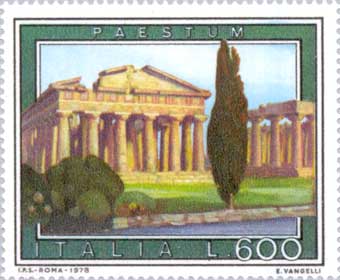
Historic buildings
The temple of Hera, built around 550 BC, is the oldest surviving temple in Paestum. Eighteenth-century archeologists named it "The Basilica" because they mistakenly believed it to be a Roman building. A basilica in Roman times was a civil building, not a religious one. Inscriptions revealed that the goddess worshiped here was Hera. Later, an altar was unearthed in front of the temple, in the open-air site usual for a Greek altar; the faithful could attend rites and sacrifices without entering the cella.
Just south of the city walls, at a site still called Santa Venera, a series of small terracotta offertory molded statuettes of a standing female nude wearing the polos headdress of Anatolian and Syrian goddesses, which were dated to the first half of the sixth century BCE, were found in the sanctuary; other similar ones have been excavated at other Paestum sanctuaries during excavations in the 1980s, but the figure is highly unusual in the Western Mediterranean.[2] The open-air temenos was established at the start of Greek ocupation: a temple on the site was not built until the early fifth century. A nude goddess is a figure alien to Greek culture before Praxiteles' famous Cnidian Aphrodite in the fourth century: iconographic analogies must be sought in Phoenician Astarte and the Cypriote Aphrodite. "In places where the Greeks and Phoenicians came in contact with one another, there is often an overlapping in the persona of the two deities," Rebecca Miller Ammerman has explained (Ammerman 1991), in identifying the cult at the site as that of Phoenician Astarte or Cypriot Aphrodite. In Roman times, inscriptions make clear, the cult was reserved to Venus.
The nearby temple, the temple of Apollo, was built in about 450 BCE. It has been in the past variously thought of as a temple dedicated to Poseidon or to Hera (as Temple of Hera II). There are visible on the east side the remains of two altars, one large and one smaller. The smaller one is a Roman addition, built when they cut through the larger one to build a road to the forum. Again, offertory statues around the larger altar are used to demonstrate that Apollo was the patron of the temple.
In the central part of the complex is the Roman Forum, thought to have been built on the site of the preceding Greek agora. On the north side of the forum is a small Roman temple, dated to around 200 BCE. It was dedicated to the Capitoline Triad, Jupiter, Juno and Minerva.
To the north-west of the forum is the amphitheatre. This is of normal Roman pattern, though much smaller than later examples. Only the southern half is visible; in 1930 AD, a road was built across the site, burying the northern half. It is said by local inhabitants that the civil engineer responsible was tried, convicted and received a prison sentence for what was described as wanton destruction of a historic site.
On the highest point of the town, some way from the other temples, is the temple of Athena. It was built in about 500 BCE, and was for some time incorrectly thought to have been dedicated to Ceres. The architecture is transitional, being partly in the Ionic mode and partly early Doric. Three mediaeval Christian tombs in the floor show that the temple was at one time used as a Christian church.
All three temples have undergone some renovation and repair in recent years. Close access is allowed, but entry by visitors into the buildings is no longer permitted.
Notes
- ^ The earliest Greek pottery found at Paestum sites dates ca 600 BCE. E. Greco, "Qualche riflessioni ancora sulle origini di Poseidionia DialArch 1 (1979) pp53-54.
- ^ Rebecca Miller Ammerman, "The Naked Standing Goddess: A Group of Archaic Terracotta Figurines from Paestum", American Journal of Archaeology 95.2 (April 1991), pp. 203-230.
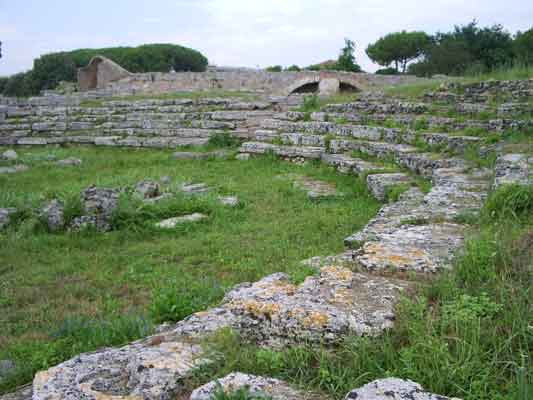
Ecclesiasterion of Paestum (place of the Ecclesia) (Source)
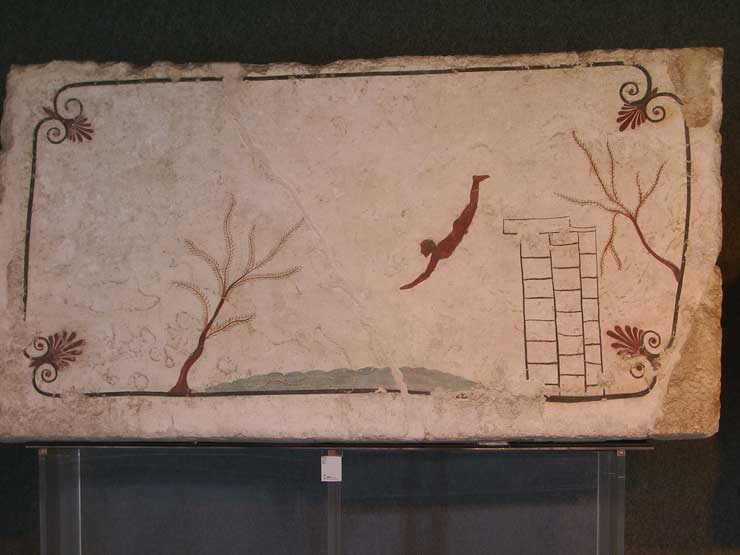
Diver of Paestum "Tomba del Tuffatore" (Source)
References
A.C. Carpiceci and L. Pennino, Paestum and Velia, Matonti, Salerno, 1995
| Ancient Greece
Science, Technology , Medicine , Warfare, , Biographies , Life , Cities/Places/Maps , Arts , Literature , Philosophy ,Olympics, Mythology , History , Images Medieval Greece / Byzantine Empire Science, Technology, Arts, , Warfare , Literature, Biographies, Icons, History Modern Greece Cities, Islands, Regions, Fauna/Flora ,Biographies , History , Warfare, Science/Technology, Literature, Music , Arts , Film/Actors , Sport , Fashion --- |
Retrieved from "http://en.wikipedia.org/"
All text is available under the terms of the GNU Free Documentation License



